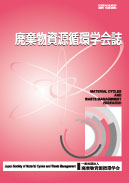Volume 27, Issue 4
Displaying 1-13 of 13 articles from this issue
- |<
- <
- 1
- >
- >|
Preface
-
2016Volume 27Issue 4 Pages 245-246
Published: August 31, 2016
Released on J-STAGE: June 02, 2020
Download PDF (206K)
Special Issue : 3R and Resource Efficiency
-
2016Volume 27Issue 4 Pages 247-251
Published: August 31, 2016
Released on J-STAGE: June 02, 2020
Download PDF (715K) -
2016Volume 27Issue 4 Pages 252-259
Published: August 31, 2016
Released on J-STAGE: June 02, 2020
Download PDF (739K) -
2016Volume 27Issue 4 Pages 260-268
Published: August 31, 2016
Released on J-STAGE: June 02, 2020
Download PDF (365K) -
2016Volume 27Issue 4 Pages 269-274
Published: August 31, 2016
Released on J-STAGE: June 02, 2020
Download PDF (411K) -
2016Volume 27Issue 4 Pages 275-284
Published: August 31, 2016
Released on J-STAGE: June 02, 2020
Download PDF (1345K) -
2016Volume 27Issue 4 Pages 285-289
Published: August 31, 2016
Released on J-STAGE: June 02, 2020
Download PDF (272K) -
2016Volume 27Issue 4 Pages 290-299
Published: August 31, 2016
Released on J-STAGE: June 02, 2020
Download PDF (380K)
Solid Waste Archives Series / Records of “Garbage War”
-
2016Volume 27Issue 4 Pages 300-304
Published: August 31, 2016
Released on J-STAGE: June 02, 2020
Download PDF (789K)
Report on the Spring Conference of the JSMCWM in 2016
-
2016Volume 27Issue 4 Pages 305-308
Published: August 31, 2016
Released on J-STAGE: June 02, 2020
Download PDF (615K)
Conference Report
-
2016Volume 27Issue 4 Pages 309-310
Published: August 31, 2016
Released on J-STAGE: June 02, 2020
Download PDF (277K)
Activity Reports from the Regional Chapters
-
2016Volume 27Issue 4 Pages 311-312
Published: August 31, 2016
Released on J-STAGE: June 02, 2020
Download PDF (246K)
Book Review
-
2016Volume 27Issue 4 Pages 313
Published: August 31, 2016
Released on J-STAGE: June 02, 2020
Download PDF (160K)
- |<
- <
- 1
- >
- >|
